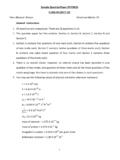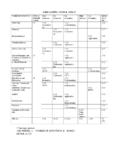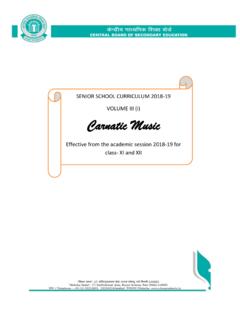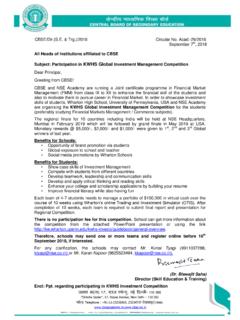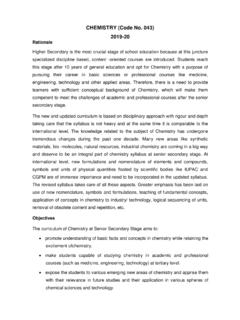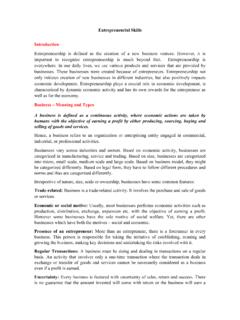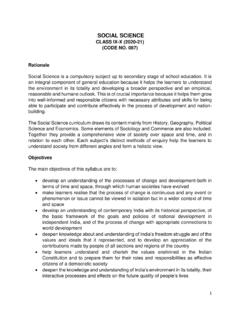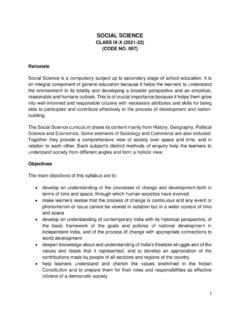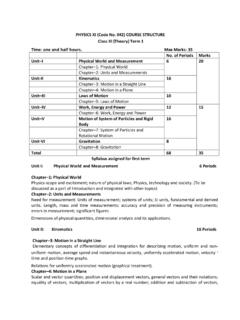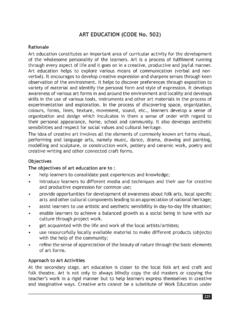Transcription of GEOGRAPHY (029) Marking Scheme (Term1) 2021-22 Class - …
1 1 GEOGRAPHY (029) Marking Scheme (Term1) 2021-22 Class - XII SECTION A 1. Which one of the following Union Territories has the highest density of population? a) NCT Delhi 2. Arrange the following approaches in a sequential order according to their development. Choose the correct option. 1. Spatial organization 2. Regional approach 3. Areal differentiation 4. Humanistic approach Options (c) 2 3 1 4 3. Panna, Para, Palli, Nagla and Dhani are examples of which of the following settlements? d) Hamleted Settlements 4. Which of the following programs sponsored by central government aims at enabling the rural population to conserve water for drinking, irrigation, fisheries and afforestation? b) Haryali 5. Population of India according to Occupation can be categorized into: a) Main workers, Marginal workers, Non workers 6. Who among the following developed the concept of human development ?
2 B) Dr Mahbub-ul-Haq 7. Which one of the following is not a plantation crop? d) Wheat 8. Which of the following best describes development ? c) A positive change in quality 9. Which of the following programme is launched by the present Union Government for the cleaning of river Ganga? b) Namami Gange 2 10. Which of the following mainly is not an industrial city? c. Chandigarh 11. Which one of the following is not a method of mining? d) Refining 12. According to census 2011, which of the following depicts the percentage of the level of urbanization in India? a) % 13. According to Census of India, migration is enumerated on which of the following basis? c) Place of Origin as well as Place of Residence 14. Clustered settlements are not found in which of the following regions of India? b) Water scarce areas of Rajasthan 15. Coffee Plantations in Brazil are known as: c) Fazendas 16.
3 Who among the following is related to capability approach ? b) Prof Amartya Sen 17. Which of the following areas of our country are deficient in rainfall and are drought prone? b) Deccan Plateau 18. Which of the following colonial super power had monopoly over sugarcane plantation in Indonesia? c) Dutch 19. Which of the following is a good example of Fort town? a) Jaipur 20. Which one of the following concepts is related to Naturalization of Humans? a) Environmental Determinism 3 21. Which one of the following is the main feature of rural settlement? a) Derive economic needs from primary activities 22. Which of the following sectors has used the highest percentage of total water in India? c) Agriculture 23. Who among the following has introduced the concept of Neo-determinism? b) Griffith Taylor 24. Which of the following attributes has not been adversely affected by Age and Skill selective migration?
4 A) Downfall in working population in rural areas SECTION B Question no. 25-29 are based on map and are mandatory to attempt.( Visually Impaired students will also attempt MCQs) 25. Choose the country with largest Geographical area in the African Continent. a). Algeria 26. Which one of the followings is a region of commercial grain farming practiced in Europe? b) Steppes 27. Which of the following is a region of North America practicing subsistence gathering? c) North Canada 28. Which of the following terminal stations connect Trans-Canadian Railway? a) Halifax and Vancouver 4 29. Which of the following is the most heavily used inland waterway of the world? c) Rhine Waterway Question no. 30-48 30. Consider the following statements and choose the correct option from the given options- 1. Population grown rapidly during the sixteenth and seventeenth century.
5 2. Expansion of world trade during sixteenth and seventeenth century is an important cause of it. d) Both statements are correct and statement 2 correctly explains the statement 1. 31. Which of the following pair is not correctly matched PILLARS OF HUMAN DEVELOPENT INDICATORS c. Productivity - Resources must be used keeping in mind the future 32. Each community occupies a well-identified territory as a matter of tradition . Above mentioned line is an important characteristic of which of the following activity? b) Nomadic herding 33. Which of the following statement is not true regarding the Smart City Mission ? d) Increase in unemployment 34. Which of the following is NOT an environmental consequence of migration? b) Mixing of diverse culture 35. In Himalayan regions which of the following tribes are linked with the activity of Transhumance?
6 C. Bakarwals 36. Match the column I with Column II and choose the correct options with the help of given Codes. COLUMN I (CITIES) COLUMN II (FUNCTIONAL SPECIFICATION) I. Ambala 1. Mining town II. Mughal Sarai 2. Transport town III. Ankaleshwar 3. Educational town IV. Aligarh town V. Shimla 5. Commercial town VI .Saharanpur 6. Tourist town 5 CODES- I II III IV V VI b. 4 2 1 3 6 5 37. This age was marked by use of computers and sophisticated statistical tools. Laws of physics were often applied to map and analyze. Select the option. d) Spatial organization 38. In which of the following streams of migration, females pre-dominate in both intra-state and inter-state migration? c) Rural to rural 39. Which of the following column is not matched correctly? ACTIVITY CHARACTERISTICS d. viticulture Rearing of fish 40.
7 Consider the following features and choose the correct title after associating them. I. More often such a pattern may also result from segregation or fragmentation of large compact village. II. The land- owning and dominant community occupies the central part of the main village whereas people of lower strata of society and menial workers settle on the outer flanks of the village. III. They are found in Gujarat plains and some parts of Rajasthan. OPTIONS- b. Semi-clustered or fragmented 41. Consider the following and choose the correct answer from the given options- I. Work participation rate tend to be higher in the areas of lower levels of economic development. II. Number of manual workers are needed to perform the subsistence or near subsistence economic activities Options- b) Both statements are correct and statement II correctly explains statement I 42.
8 Consider the following statements and choose the correct option for the same: 1. Grape cultivation is the specialty of the Mediterranean agriculture. 2. Wines are produced from high quality grapes and the inferior grapes are dried into raisins and Currants. Options; b. Both 1 and 2 are correct 6 43. Match the column I with column II and choose the correct answer with the help of given Codes. COLUMN I (RIVERS) COLUMN II (POLLUTED PLACE) I Yamuna 1. Hyderabad II Kali 2. Kanpur and Varanasi III Gomati 3. Ahmedabad IV Sabarmati 4. Lucknow V Ganga 5. Muzaffar Nagar VI Musi 6. Delhi and Etawah Codes- I II III IV V VI a. 6 5 4 3 2 1 44. In the year 2015, a policy was formulated for the adolescents to give them proper guidance and the better development of their talent. Select the correct answer. a) Skill development and entrepreneurship 45.
9 Which of the following pairs is not matched correctly? CITIES BASIS OF DEVELOPMENT c) Kolkata -On cultural basis 46. Match the column I with column II and choose the correct answer with the help of given Codes- COLUMN I (CITIES) COLUMN II (TYPES OF CITIES) I Jamshedpur resort II. Bhuvaneshwar 2. Satellite town III. Ghaziabad 3. Industrial town IV Mussoorie 4. Commercial port V Goa 5. Administrative town CODES- I II III IV V b. 3 5 2 1 4 47. Consider and evaluate the following statements than choose correct options for them from the given options. 1. Many species now have become extinct or endangered due to illegal hunting. 7 2. The early hunters used primitive tools made of stones, twigs or arrows so the number of animals killed were limited. Options; c) Both statements 1 and 2 are correct 48.
10 Make correct pairs of the following two columns and select the correct option. Period Approach 1. Early colonial period (a) Exploration & Description 2. Late 1950 s to the late 1960 s (b) Regional Analysis 3. Later colonial period (c) Aerial Differentiation 4. 1930 s through the inter-war period (d) Spatial Organization (A) 1. (a) 2. (d) 3. (b) 4. (c) SECTION C SOURCE BASED QUESTIONS Question number 49 to 52 are compulsory to attempt Jal Kranti Abhiyan (2015-16) Water is a recyclable resource but its availability is limited and the gap between supply and demand will be widening over time. climate change at the global scale will be creating water stress conditions in many regions of the world. India has a unique situation of high population growth and rapid economic development with high water demand.
